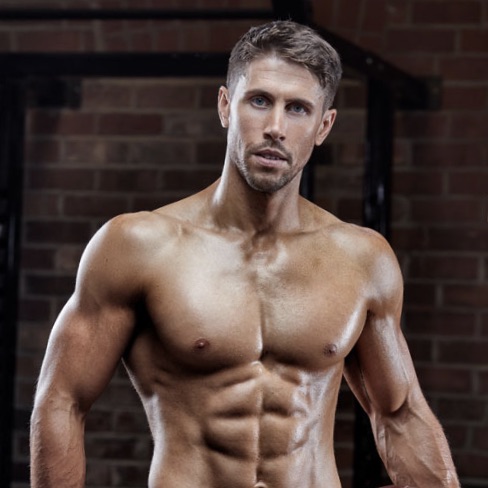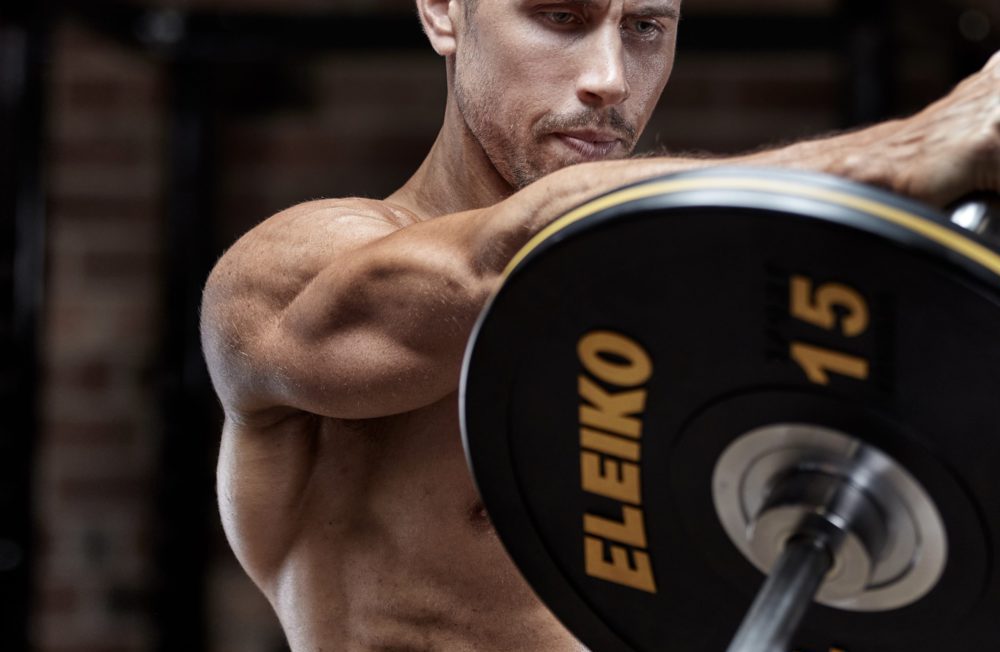In Part 1 I covered the staple biceps exercises you should be including in your workouts. Spending most of your time perfecting and executing these will provide you with the majority of your results in the long run. Today in Part 2 I share the triceps exercises that should form the “big rocks” of your training plan for bigger arms. Let’s dive right in.
Narrow-grip floor presses
To build bigger arms you should be performing the most effective exercises first in your workouts. What are the most effective exercises for triceps? These are the exercises that optimally recruit all three heads of your triceps. Your triceps include the long, medial and lateral heads. Exercises that do a great job at recruiting all of these should be prioritized. Both narrow-grip presses and v-bar dips are excellent options.
Risk versus benefit ratio needs to be considered with any exercise, though. This is especially true with those exercises that involve the commonly troubled shoulder joint. Close-grip floor presses are far more effective for the majority of the population. They’re relatively shoulder- and elbow-friendly when compared to v-bar dips.
Using a close-grip works to increase triceps recruitment, while the reduced range of motion of the floor press limits the amount of potential wear on the shoulders. V-bar dips and regular close-grip bench presses are great, but if you’re to choose only “big” triceps move then narrow-grip floor presses take the top spot. Especially in the long run.
Other variations you should try: Narrow-grip floor presses with band resistance, narrow-grip bench presses on a slight decline, narrow-grip board presses, v-bar dips with modified technique.
Lying triceps extensions
Because all three heads of the triceps join at the same common tendon it’s impossible to solely isolate a single area. That being said the long-head of your tricep can be influenced by the angle at your shoulder when doing an exercise. This is possible since the triceps long head crosses over the shoulder joint. Applied to your training, for example, doing triceps exercises with your arm overhead will place more tension through the long-head, loading it at longer lengths.
If you’ve ever done a bunch of overhead triceps exercises in the same workout and woken up the next day with excruciating triceps DOMS, you’ll know what I’m talking about. Loading the triceps long-head at greater lengths can cause a lot of mechanical tension and tissue breakdown, as well as next-day muscle soreness (and the love/hate that comes with that).
Triceps extensions are one of the best ways to hit your triceps long-head at longer lengths. You can vary the incline of the bench to bias other areas of your triceps, too. As an example doing these on a slight decline will allow you to maintain more tension at the top of the triceps extension. However this can be at the expense of the loading received in the lengthened position at the bottom of the exercise.
Does bench angle matter?
Using a flat bench there’s an overall greater contribution of the lateral and long-head of the triceps. An incline bench, or even going in to a French press has its benefits as well. Neither variations and angles are “better”, as each have their own unique benefits. It always comes down to picking the right tools for the person and purpose.
Other ways to get overhead: Triceps extensions with a cable, triceps extensions with dumbbells, rolling triceps extensions, PJR pullovers, bodyweight or TRX triceps extensions, different grips and angles.
Triceps pushdowns
Triceps pushdowns are a staple exercise for many, but rarely appreciated or done right. If there’s one simple rule you should be aware of when trying to build any muscle; if you don’t feel an exercise working that area then you should just scrap it. We could add to that by also stating that if you’ve experienced unwanted pain when doing a particular exercise, then you should scrap that one too. Triceps pushdowns, especially using a rope, tend to be a safe bet for most people, which is why they’ve made this list.
Triceps pushdowns using a rope place your elbows in better alignment than many other common triceps exercises. The rope beats many other cable attachments, too, ensuring your triceps are well-targeted without beating-up your elbows.
Pushdowns effectively target all three heads of your triceps, although tend to bias more medial and lateral heads. This is one of the reasons why, as we’ve already mentioned, doing some extra work overhead is beneficial as it stops the long-head from being neglected.
Which pushdown technique is best?
Hang around any gym for a few hours and you’ll likely see half a dozen different techniques when doing pushdowns. And, just like varying the angle of your bench, neither are necessarily better nor worse.
Keeping your elbows fixed to your sides more, better isolates elbow extension, shifting more weight directly to your triceps. This is compared with the technique shown above which allows a more continuous load from the cables. This is because the cable stays closer to the optimal 90 degree angle from the arms throughout the entire movement.
What’s more important when you choose your technque, though, is that you use the technique you feel working your triceps the hardest. Adding the little “turnout” of the rope at the bottom of the pushdown can help with that. Research has shown this little technique tweak to significantly increase triceps recruitment.
Other ways to do pushdowns: X Cable pushdowns, Low-pulley lying pushdowns, resistance band pushdowns, various grips and attachments.
Programming
For an arms-building workout, the order of triceps exercises you’ve seen today would work best for most. That being said if you have trouble feeling your triceps when doing narrow-grip presses or dips, I’d highly recommend performing your triceps pushdowns first. This exercise strategy will work to isolate and pre-fatigue your triceps before hitting it with your “big” triceps lift.
When trying to build muscle then increasing poundages is important. But this should not be at the expense of technique, feeling, and optimizing tension. Broadly, sets of 8-15 reps work well for all of these triceps exercises. Combine these with the exercises biceps exercises from Part 1 for a complete arms-building workout.

I build Olympians, Cover Models and those who want to look like them. Author or “Ultimate Abs” available in all good book stores.
